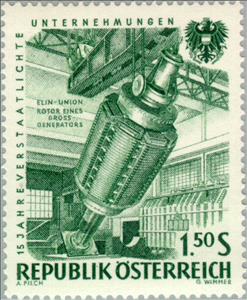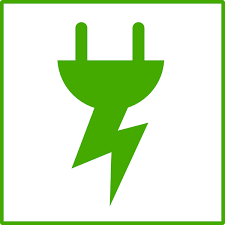Stamp: Rotor of a huge generator of the Elin Union (Austria 1961)
Rotor of a huge generator of the Elin Union (Austria 1961)
15 September (Austria ) within release State Companies goes into circulation Stamp Rotor of a huge generator of the Elin Union face value 1.50 Austrian schilling
| Stamp Rotor of a huge generator of the Elin Union in catalogues | |
|---|---|
| Michel: | Mi:AT 1093 |
| Yvert et Tellier: | Yt:AT 933 |
Stamp is vertical format.
Also in the issue State Companies:
- Stamp - Shaft tower of the Wolkersdorf shaft face value 1;
- Stamp - Rotor of a huge generator of the Elin Union face value 1.50;
- Stamp - Blast furnaces, Austrian Alpine Montane Corporation face value 1.80;
- Stamp - LD Steel Works, Voest, Linz face value 3;
- Stamp - Oil Refinery, Schwechat der ÖMV A.G. face value 5;
Stamp Rotor of a huge generator of the Elin Union it reflects the thematic directions:
In microeconomics, an industry is a branch of an economy that produces a closely related set of raw materials, goods, or services.For example, one might refer to the wood industry or to the insurance industry.
In physics, energy (from Ancient Greek ἐνέργεια (enérgeia) 'activity') is the quantitative property that is transferred to a body or to a physical system, recognizable in the performance of work and in the form of heat and light. Energy is a conserved quantity—the law of conservation of energy states that energy can be converted in form, but not created or destroyed. The unit of measurement for energy in the International System of Units (SI) is the joule (J).
A coat of arms is an heraldic visual design on an escutcheon (i.e. shield), surcoat, or tabard. The coat of arms on an escutcheon forms the central element of the full heraldic achievement which in its whole consists of shield, supporters, crest, and motto. A coat of arms is traditionally unique to an individual person, family (except in the United Kingdom), state, organisation or corporation.
A crane is a machine used to move materials both vertically and horizontally, utilizing a system of a boom, hoist, wire ropes or chains, and sheaves for lifting and relocating heavy objects within the swing of its boom. The device uses one or more simple machines, such as the lever and pulley, to create mechanical advantage to do its work. Cranes are commonly employed in transportation for the loading and unloading of freight, in construction for the movement of materials, and in manufacturing for the assembling of heavy equipment.




